So, yeah....I'd put together a project list at Mouser for the 1484 head (number 1) that consisted of every resistor and capacitor. It would've come to a bit over $100 if I'd pulled that trigger. One day I was looking at Weber's site....and saw they carried resistors and capacitors. Hmm...so I put together an order for everything and it came to less than $40! Trigger pulled!
The parts came in over last weekend, so this week I've been digging in the Silvertone. Let me tell you. working on a point to point terminal strip amp is a major bitch. I was trying to properly desolder and remove all the components I wanted to replace, but there are times I just had to cut leads and find a way to make a good connection on the terminal strip. I also ended up needing to splice wires a number of times to extend them, versus completely replacing the wire. Not pretty, not the absolute best lead dress, but it worked.
I'm not done with the 1484 yet, but making good progress. All the electrolytics are new. New power cord, ground switch dissabled. Some of the crappy ceramic disc caps swapped for polyesters. Slowly going through and checking resistors. Best part is, I test my work from time to time and it's all good thus far. I still have some caps I want to replace, and a lot of resistors to check, but it's sounding great and the reverb and tremolo are working...as well as can be expected anyway.
One major thing I did was to change the standby switch to a Fender style. The original was just strange in that it shorted the phase inverter together. I moved it to right before the choke, much like most Fender amps. Much better, IMHO. Screwed up initially though...I disconnected the wires from the standby switch and, without thinking, spliced them together before moving on to changing the switch over. I had done this along with a number of other things, and when I fired the amp up it wasn't working properly.....very, very low output, almost none at all. Uh-oh...
I checked everything over twice and checked all solder joints...and couldn't figure out what was going on. It sounded familiar, just like it did before the standby switch change when the amp was on standby, actually. I remembered this and did some googling....and realized I should have just removed the old standby switch wires, not splice them together...because in doing so I hard wired the damn amp into permanent standby! Ha! It was late....give me a break.
Anyway, I've created a album with some photos....and here's a link showing my revised schematic...changes noted in red, components R&R'd or revised (thus far) highlighted in yellow..I will update this as I do more. Tremolo circuit next!
 |
| From Silvertone 1484 #1 |
















































